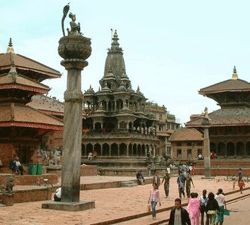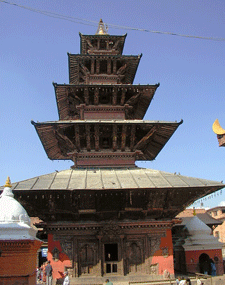|

Welcome
|
|
|
|
|
|
|
|
|
|
|
|
|
|
|
|
|
|
|
|
|
|
|
|
|
|
|
|
|
|
|
|
|
|
|
|
|
|
|
|
|
|
|
|
|
|
|
|
|
|
|
|
|
|
|
|
|
|
|
|
Patan
|
|
Information about Patan |
|
Patan, also known as Lalitpur is situated about 5 kms. south-west of the Kathmandu valley. Patan is the second largest city of Nepal and known for its artistic temples and sculptures. Patan
is the most artistic and architectural centre of the valley
due to the famous Durbar Square, 55 major temples and 136
monasteries. The visitors can buy superb souvenirs in
paintings, bronze, brass, stone and wood. |
|
|
|
History of Patan |
|
Patan has a long history and was also the most famous Buddhist centre. Patan was once an independent kingdom under Malla rulers and a centre of craftsmanship. Ashoka, the Mauryan emperor was responsible for the construction of four earth and brick directional stupas at the four corners. Later under the Mallas, the city experienced a great flourish of temple building. The relatively compact scale and the remarkable temple architecture gave the Patan, a unique atmosphere. The city of Patan is steeped in Buddhist history. Shrines, temples, and viharas were built that became the geographic focus of the Newar Buddhist community. Newar Buddhism developed along side the viharas in Kathmandu. It was institutionalized as a unique cult of Mahayana Buddhism in the 9th century, due to the substantial number of viharas, and the highly developed valley culture with its distinct characteristics. It has its own script, literature, rituals, and discipline. |
|
|
|
Tourist Attractions in Patan |
|
There are about 55 temples and 136 monasteries in Patan. It is believed that these monasteries were first built by the king Mandev of Lichchhavi dynasty. Patan also has a zoo that houses various specimens of Himalayan and Terai wildlife including deer and the Bengal tiger. The main tourist attractions in Patan are Durbar Square, Mahaboudha Temple, Hiranyavarna Mahavihara or Golden Temple or Kwa Bahal and Kumbheshwar Temple.
|
|
|
Hiranyavarna Mahavihara
The Hiranyavarna Mahavihara is the most important monastery in Patan. Hiranyavarna Mahavihara, also known as the Golden Temple and Kwa Bahal, was established by King Bhaskardev Verma in 1018. This monastery takes its name from the gold-plated roof which was dedicated by a rich merchant. This monastery is visited by various devotees and tourists. This monastery is very unique as it preserves the traditions of the Vajrayana sect of Buddhism. This monastery is a lively, vibrant and open museum full of the Newar Buddhist pantheon, in masterpieces of art and sculpture reflecting Buddhist thought and way of life. Inside the shrine is a frieze that depicts the life of the Buddha, prayer wheels and the strong Hindu component of some images that indicate the extent of religious cross-fertilization in the valley. The courtyard has a richly decorated three-storey temple with a golden image of Lord Buddha. |
|
|
Durbar Square
Durbar Square is located in the centre of the city. It has ancient palaces, Hindu temples, Buddhist shrines and many fascinating sculptures. Most of the buildings were built during the 13th century by the Malla king Siddhi Narsingh. In Durbar Square, the ancient Royal palace and temple are situated on the right side. Towards the west are Krishna Temple and various other temples. Patan’s biggest marketplace, the Mangal Bazar, is also a part of the Durbar Square. The first temple to the right of the square is the three-storey Bhimsen Temple. This temple has a lion pillar in front of it and was built in 1682. Near this temple is the Vishwanath Temple. This two-storey temple is dedicated to the Lord Shiva and has a linga. The two stone elephants guard the entrance and Nandi, the Bull guards the rear. The Krishna Temple is set further back
|
 |
|
from the main temple. This temple is built using the stone and
a combination of the early Mughal and Nagara styles of temple architecture.
The Garuda kneels atop a pillar and faces the temple. The carvings on its pillars have the various fine scenes from the Mahabharata on the first floor and the Ramayana on the second floor. Also set on a high pillar is the statue of King Yoganarendra Malla who ruled Patan in the 18th century. A bird sits on top of the statue and according to the legends, as long as the bird remains on the statue, the king may return to its palace. The Royal Palace is a fine three-storey structure marked by its golden gate and bronze windows. It is believed that the spirits of the Malla kings still reside there. This palace has the carved roof struts and the gilded metal window over the entrance is flanked by carved ivory windows. |
|
|
|
 |
Kumbheshwar Temple
The Kumbheshwar Temple is situated nearby Durbar Square. This 5-storeyed temple is dedicated to Lord Shiva and the oldest temple in
Patan. There is a tank in the courtyard and it is said that water comes directly from the holy lake, the
Gosainkunda. It is finely proportioned with numerous carvings including the figures of Ganesh, Narayan and other deities. There are small Bhairab and Baglamukhi temples around the main structure.
Mahaboudha Temple
The Mahaboudha Temple, also known as the temple of one thousand Buddhas is located at the south of Durbar Square. This temple was built in the 16th century and severely damaged by an earthquake in 1934. This temple of terracotta and tile is tightly secured by the surrounding buildings. This temple looks like the Mahabodhi temple at Bodhgaya in Bihar. Each brick used in the temple contains an image of the Buddha. From the top, you can have a good look of the Patan town. |
|
|
|
|
Rato Machendranath Temple
The Rato (Red) Machendranath Temple is situated a little away from the centre of Patan. This temple is considered by the Buddhists as the home of the god Avalokiteshwara in his Tantric form. This temple belongs to 1673 and stands in a courtyard filled with sculptures of horses, lions and bulls, symbols of the Tibetan calendar. There are four richly adorned entrances that leads to the shrine which houses the large-eyed clay image of Avalokiteshwara, decorated with jewellery and garlands. |
|
|
|
Tibetan Refugee Camp
The Tibetan Refugee Camp is loacted at Jawalakhel. In 1959, following the flight of Dalai Lama and other Tibetans, various refugees were accommodated in the Tibetan Refugee Camp. This camp was set up with the Swiss assistance and now, a
permanent settlement. This place also has a handicrafts centre that sell carpets, blankets, jackets and pullovers made by the refugees there and here, you can also see these things being made by them. |
|
|
|
|
Festivals in Patan |
|
Every monastery has its own annual festival that commemorate its founding. This is the day when the entire sangha (Members belonging to a particular
monastery) enthusiastically assembles for religious exercises and feasts. The other important occasion for the Newar Buddhist community is Gunla Dharma.
Gunla is the Newar month (mid-July to mid-August) sacred for Buddhists. Patan also celebrates Malaya or the festival of lights. This occurs on the second day
of Gunla. The devotees carry lighted tapers, candles, and torches, and march in groups and visit the various monasteries in the city. The Rato
Machhendranath is another festival of Patan. In this festival, the red faced image of the patron deity is taken around the city and his chariot moves in daily
stages in a procession during the celebrations in Patan. The procession is accompanied by musicians and soldiers and viewed not only by the royal family,
but also by the Patan's Kumari, the "Living Goddess". |
|
|
|
|
|